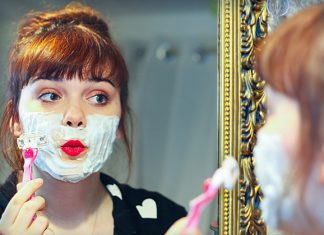The areolas are the small and circular pigmented areas surrounding the nipples like a ring. Just like breasts, areolas too vary in shapes, sizes, and colours.
It is entirely reasonable to have different sized and coloured areolas compared to others. However, the disproportionate areola can ruin the appearance of the breasts.
If you feel uncomfortable with the increased size of areolas, worry no more because there are several ways to reduce it. Surgery for areola reduction is relatively a simple one which will help to reduce the diameter of one or both areolas.
Areola reduction surgery can be performed in accompaniment with the breast lift procedure, breast augmentation or even reduction.
Who can undergo areola or nipple reduction surgery?
Anybody who is not happy with the size or shape of the areola can go for an areola reduction surgery. In fact, even men can go for this option.
The surgery procedure will suit you better if you have recently lost weight and your areolas have become stretched. Areolas also change during breastfeeding and pregnancy.
Some people also have puffy and protruded areolas. People with asymmetrical areolas can get them back in the right shape and size with the help of surgery.
While adolescent males can undergo the areola reduction surgery, females should wait till their breasts have developed completely; i.e., they should at least reach their early 20s.
Areolas and nipples can be large and misshapen due to several factors like genetics, trauma, ageing, pregnancy, breastfeeding, etc. This affects the appearance of the breasts and makes them look odd. You may even feel embarrassed or uncomfortable exposing your breasts to someone. For people with large nipples, they are limited to wear only the selected type of clothes. To solve the problem of large nipples, you can visit your surgeon to reduce the size of the nipples. Unless the nipple reduction is made, styling becomes a limited option. Moreover, large nipples also cause irritation and sensitivity.
However, issues like the following can be resolved with surgery.
- Long nipples
- Droopy nipples
- Puffy areolas
- Enlarged areolas
Nipples/Areola reduction surgery costs
The nipples or areola reduction surgery cost varies from one geographic location to the other. Also, the type of procedure you take determines the cost of the surgery. Moreover, if you undergo surgery on both breasts, then naturally, the price will increase.
Additionally, the cost will be even higher if you combine the surgery with a breast lift or breast reduction. Areola reduction surgery cost will range from $2000 to $5000. Nipple reduction cost for one breast will be around $1000, and for two breasts, it will add up to $2000. This type of surgery come under cosmetic surgery and is not covered by insurance.
The entire amount will have to be paid from your own pocket. Some clinics provide plans for payments that can help you to afford the surgery without a holdup.
Choosing a Plastic Surgeon
Choosing the right surgeon for your nipple or areola reduction surgery is essential. Certified plastic surgeons belong to a higher standard than cosmetic surgeons. Plastic surgeons certified by the Boards have a minimum experience of 6 years of surgical training.
Make sure to check the portfolio of the surgeon you are considering. This will make you feel secure before you undergo surgery.

How to prepare for the surgery?
Once you know your surgeon well, you can consult them to know the surgery procedure properly. Your doctor will ask for all the details concerning your medical history. The surgeon will examine your breasts and listen carefully to your aesthetic concerns. If you are already under any medication due to other health conditions, make sure to inform the same to the surgeon.
The surgeons will make sure that your expectations are possible and realistic. Scarring is possible after the surgery is completed, and the surgeon will show you the likely places.
The doctor or the surgeon will fix a date suitable for you for the surgery during the discussion. All the other details related to preparation for the operation will also be shared with you. Some of those are:
- Avoid certain medications, such as aspirin and ibuprofen, at least for a week before the surgery date
- Avoid vitamins and herbal supplements few days before the surgery
- The schedule time of your procedure and the recovery process
- To arrange your ride to and from the clinic
- Tell you to fast a day before the surgery, especially if general anesthesia will be carried out
- Shower with surgical soap on the date of the surgery
- To not wear make-up and cosmetics
- To remove all the pieces of jewelry
- To wear relaxed-fit and comfortable clothes
How is the procedure performed?
The surgery will be performed under the effect of local anaesthesia and usually takes an hour to complete. You can return home after the operation gets over. Due to the effect of local anaesthesia, you might feel drowsy even after the surgery is over. So it is better to keep the transportation ready on prior.
A doctor will make a small incision on the nipple for the surgery. For areola reduction surgery, the surgeon will mark an incision around the areola’s perimeter. Usually, the incision heals very quickly.
The surgeon will remove the extra tissue from the incision area. The incision will be closed by the stitching method. A gauze dressing will also be used. A small surgical bra will be placed on the breasts after the surgery to ensure that the breasts are held adequately for better healing.
Possible risks and complications of the nipple or areola reduction surgery
Areola or nipple reduction surgery is safe, but there are always some side effects or risks involved in every surgery. These are:
- Temporary loss of sensation
- Scarring
- Inability to breastfeed
- Infection
It will take a few weeks to praise the results of the reduction surgery. Initially, you may experience bruises and swelling. Over time the breasts will settle in the proper position. Your areolas and nipples will appear small and centred. Scars can show up around the outer edge of the areolas and near nipples. This can take a year to heal up completely.
Keep consulting your doctor even after the surgery. The doctors will remove the stitches if required and check the healing process. You will be asked to get topical medications to reduce the scar marks.
If you experience the following, then call your doctor immediately:
- Fever
- Inflammation
- Severe redness
- A sudden increase in pain
- Pus leaking from the incision site
- Very slow healing
It would help if you never ignored such serious symptoms post-surgery.






